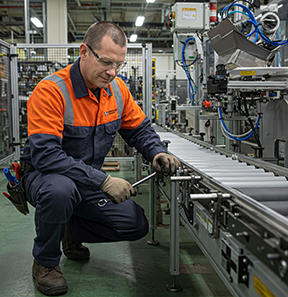Published: August 11, 2015 | Updated: September 18, 2025
Published: August 11, 2015 | Updated: September 18, 2025
Beyond Belief: Manufacturing Blunders and the CMMS Solution
The Human Element in Manufacturing: When Things Go Wrong
 Human ingenuity has driven incredible feats of engineering and manufacturing throughout history. We marvel at structures like the Hoover Dam and the intricate processes that produce modern electronics. Yet, despite meticulous planning and skilled labor, errors infiltrate even the most sophisticated operations. These mistakes range from the minor, causing slight inconvenience, to the catastrophic, resulting in significant financial losses, safety hazards, and reputational damage. Let's look at manufacturing blunders and the CMMS solution.
Human ingenuity has driven incredible feats of engineering and manufacturing throughout history. We marvel at structures like the Hoover Dam and the intricate processes that produce modern electronics. Yet, despite meticulous planning and skilled labor, errors infiltrate even the most sophisticated operations. These mistakes range from the minor, causing slight inconvenience, to the catastrophic, resulting in significant financial losses, safety hazards, and reputational damage. Let's look at manufacturing blunders and the CMMS solution.
Consider the everyday frustration of a misplaced door handle. The text uses this relatable scenario to illustrate how easily a seemingly straightforward installation can deviate from the intended design. While a misplaced door handle presents a minor annoyance, it underscores a breakdown in process, communication, or quality control.
In a manufacturing setting, similar oversights, such as incorrect component assembly or miswiring, can have far more serious consequences, leading to product defects, malfunctions, and potential safety risks for end-users.
Beyond Construction: A Spectrum of Manufacturing Mishaps
The "door to nowhere" and the awkwardly placed restroom fixtures described in the text serve as humorous yet poignant reminders of errors in planning and execution. These construction blunders have parallels across various manufacturing sectors.
Imagine a scenario in a food processing plant where incorrect ingredient proportions slip into a batch due to a misread formula or a malfunctioning scale. This error, unlike a door to nowhere, has direct implications for product quality, safety, and regulatory compliance, potentially leading to costly recalls and damage to brand reputation.
In the automotive industry, a seemingly minor oversight during the assembly process, such as the incorrect tightening of a bolt or the installation of a wrong part, can have critical safety implications. These errors might not become immediately apparent but can lead to vehicle malfunctions and increase the risk of accidents. The consequences extend beyond financial repercussions to potential legal liabilities and, most importantly, the safety of consumers.
The Leaning Tower of Pisa, arguably the most famous construction mistake, exemplifies how foundational errors can have long-lasting and significant impacts. The text correctly identifies a poorly laid foundation and loose substrate as the likely culprits.
In manufacturing, analogous foundational errors might include flawed initial designs, selection of inappropriate materials, or
inadequate calibration of machinery. These upstream mistakes can propagate through the entire production process, leading to consistent defects and requiring extensive and costly rework or even product recalls.
The Cost of Errors: More Than Just Rework
Manufacturing mistakes incur a multitude of costs that extend far beyond the immediate expense of rework or scrapped materials. These costs include:
- Lost Productivity: When errors occur, production lines halt, and valuable time gets spent identifying, rectifying, and preventing recurrence.
- Material Waste: Defective products often necessitate the disposal of raw materials and components, increasing operational costs.
- Warranty Claims and Recalls: Faulty products reaching consumers can lead to expensive warranty claims and, in severe cases, costly and reputation-damaging product recalls.
- Damage to Reputation: Consistent quality issues erode customer trust and negatively impact brand image, potentially leading to decreased sales and market share.
- Legal Liabilities: In cases where defective products cause harm or injury, manufacturers face potential lawsuits and significant legal expenses.
- Safety Hazards: Manufacturing errors can create unsafe working conditions for employees and lead to accidents and injuries.
 The Proactive Power of a CMMS in Error Prevention
The Proactive Power of a CMMS in Error Prevention
We can never underestimate the value of proper planning, attention to detail, and budget adherence in preventing construction and manufacturing errors. These principles are fundamental to any successful operation. However, managing these elements effectively across complex manufacturing processes requires more than just good intentions; it demands systematic tools and processes. This is where a Computerized Maintenance Management System (CMMS) emerges as a powerful ally in the proactive prevention of manufacturing mistakes.
Centralized Data and Documentation
A CMMS acts as a central repository for all critical maintenance-related information. This includes equipment specifications, maintenance schedules, repair history, standard operating procedures (SOPs), and safety protocols. By consolidating this data, a CMMS ensures that all relevant personnel have access to the correct information at the right time. This reduces the likelihood of errors arising from outdated documentation, miscommunication, or a lack of clarity regarding procedures. For instance, clear and readily accessible SOPs within a CMMS can guide technicians through complex assembly processes, minimizing the chance of incorrect component installation – a more complex version of the misplaced door handle.
Automated Work Order Management
The work order management functionality within a CMMS streamlines the process of assigning, executing, and tracking maintenance tasks. Digital work orders clearly outline the required work, specify the equipment involved, and can include detailed instructions, diagrams, and even visual aids. This reduces ambiguity and ensures that maintenance activities are performed according to established procedures.
Scheduled preventative maintenance work orders, generated by the CMMS, ensure that equipment receives timely upkeep, reducing the risk of breakdowns and the potential for errors caused by malfunctioning machinery–a proactive measure against the foundational errors exemplified by the Leaning Tower's instability.
Enhanced Communication and Collaboration
A CMMS facilitates communication and collaboration among different departments, including maintenance, production, and quality control. When an issue arises, maintenance personnel can quickly log the problem, assign it to the appropriate technician, and track its progress. This real-time communication ensures that problems are addressed promptly and efficiently, preventing minor issues from escalating into more significant errors. Furthermore, the ability to attach notes, images, and other relevant information to work orders provides valuable context and improves the accuracy of repairs and troubleshooting.
Detailed Reporting and Analytics
One of the most significant advantages of a CMMS is its reporting and analytics capabilities. The system can generate reports on various metrics, including equipment downtime, maintenance costs, work order completion rates, and the frequency of specific equipment failures. By analyzing this data, manufacturers can identify trends, pinpoint recurring issues, and gain valuable insights into their maintenance operations. This approach allows for the implementation of targeted preventative maintenance strategies and process improvements to mitigate the risk of future errors.
For example, if the CMMS data reveals a recurring issue with a specific machine component, engineers can investigate the root cause and implement design changes or enhanced maintenance procedures to prevent future failures and associated production errors.
Inventory Management and Control
Many CMMS solutions include inventory management modules that track the availability and usage of spare parts and materials. This feature helps to ensure that the correct parts remain available when needed, preventing delays and the temptation to use incorrect or substitute components that could lead to product defects. Accurate inventory tracking also minimizes waste and reduces the risk of ordering errors.
Accountability and Audit Trails
A CMMS provides a detailed audit trail of all maintenance activities, including who performed the work, when it was completed, and any parts used. This accountability helps to identify potential sources of error and ensures that individuals are responsible for their actions. The historical data stored within the CMMS can also be invaluable for Root Cause Analysis (RCA) when errors do occur, allowing manufacturers to understand the underlying causes and implement corrective actions to prevent recurrence.
The narrative of manufacturing is punctuated by both triumphs of innovation and cautionary tales of errors. While the human element inherently introduces the possibility of mistakes, the evolution of technology provides powerful tools to mitigate these risks. A CMMS transcends its function as a mere maintenance tool; it acts as a proactive guardian against the spectrum of manufacturing mishaps. By fostering organization, enhancing communication, and providing data-driven insights, a CMMS empowers manufacturers to move beyond reactive fixes and cultivate a culture of preventative diligence, ultimately shaping a future where production processes achieve greater levels of accuracy and reliability.
FAQs
What are some common manufacturing mistakes?
Manufacturing errors can include incorrect assembly, design flaws, miscommunication, or poor-quality control, leading to costly defects and safety risks.
How do manufacturing blunders affect companies?
They cause downtime, material waste, recalls, legal liabilities, and damage to brand reputation.
What role does a CMMS play in preventing errors?
A CMMS centralizes data, schedules preventive maintenance, and ensures accurate work orders to reduce mistakes.
How can CMMS improve communication in manufacturing?
It streamlines collaboration between departments, allowing real-time issue tracking and faster problem resolution.
What reporting advantages does a CMMS provide?
It generates analytics on downtime, costs, and failure trends, helping manufacturers prevent recurring errors.
How does MAPCON’s CMMS support manufacturers?
MAPCON’s CMMS offers work order automation, inventory tracking, and audit trails, giving manufacturers better control and reliability.
MAPCON | 800-922-4336
MAPCON CMMS software empowers you to plan and execute PM tasks flawlessly, thanks to its wealth of features and customizable options. Want to see it for yourself? Click the button below to get your FREE 30-day trial of MAPCON!
Try It FREE!